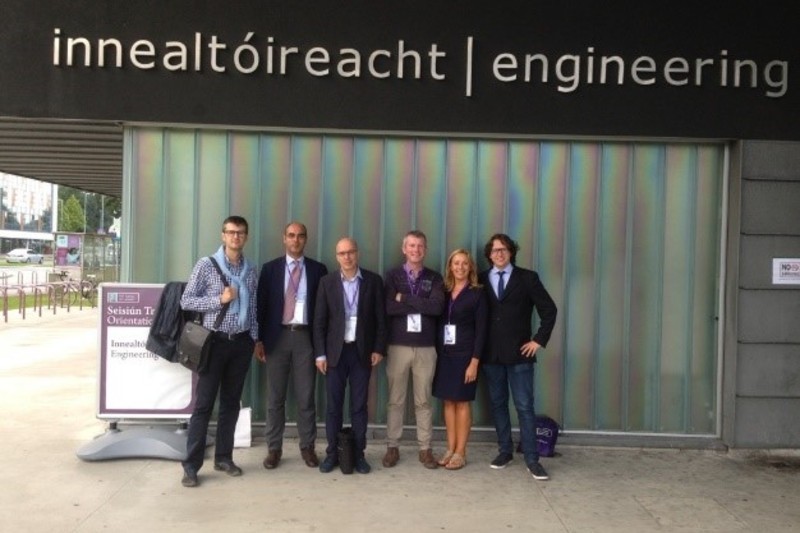Eirocrete: Development of sustainable, lower carbon, pre-cast concrete infrastructure
This innovative research accrues from the technological approach used to develop sustainable concrete products with a significantly lower carbon footprint and the demonstration of this improved sustainability by the Academic Partners from UK and Italy collaborating with a leading pre-cast concrete manufacturer, Banagher Precast Concrete in Ireland and specialists in leading-edge technologies and products for the construction industry, Azichem in Italy. This project takes place over four years and will involve the secondment of researchers from academia to industry and vice versa.
The major aim of this project is to develop lower energy, durable concrete products for use in civil infrastructure by maximising the inclusion of waste products and to combine with corrosion resistant basalt fibre reinforced polymer (BFRP) fibres and reinforcing bars which are stronger, lighter and have a lower carbon footprint than equivalent steel rebar.
Bridges suffer from premature ageing and rapid deterioration which can lead to structural deficiency with ensuing implications for the safe management of risk with increased loadings. Most of this deterioration is a result of the corrosion of the steel reinforcing bars (rebars) embedded in the concrete.
The project also aims to reduce the cost of precast W-beams for bridge by using SCC and using BFRP eliminate corrosion in these infrastructures. This project aligns with the need for future sustainable infrastructure with a reference to EU strategy to reduce greenhouse gas emissions by 20% compared to 1990 levels by 2025.
The savings in natural resources and the associated reduction in energy utilisation and CO2 emission will contribute to preserving our natural world and landscape. It is estimated that approximately 1 tonne of CO2 is released for each tonne of cement produced and, hence, the replacement of cement with waste materials will reduce the amount of CO2 emissions.
This European project was funded by the European Commission – Marie Curie Actions (2013-2017).
Recent papers published by the Research group:
L. Ferrara, P. Deegan, A. Pattarini, M. Sonebi, S. Taylor, “Recycling ceramic waste powder: effects its grain-size distribution on fresh and hardened properties of cement pastes/mortars formulated from SCC mixes”, Journal of Sustainable Cement-Based Materials, https://www.tandfonline.com/doi/abs/10.1080/21650373.2018.1564396
Bruno Dal Lago, Su E. Taylor, Peter Deegan, Liberato Ferrara, Mohammed Sonebi, Philip Crossett, Andrea Pattarini “Full-scale testing and numerical analysis of a precast fibre reinforced self-compacting concrete slab pre-stressed with basalt fibre reinforced polymer bars”, Journal Composites Part B, 2017: http://dx.doi.org/10.1016/j.compositesb.2017.07.004
Dal Lago, B., Ferrara, L., Taylor, S., Sonebi, M., Deegan, P., Kelly, G., Pattarini, A. (2016). “Design of steel-free pre-stressed reinforced concrete slabs: theory and experimentation”, ACI Italy Chapter: The New Boundaries of Structural Concrete 2016, Capri island, Italy, 29th September – 1st October 2016, 137-146, ISBN: 978-88-98720-14-9.
Peter Deegan, Su E. Taylor, Mohammed Sonebi, Liberato Ferrara, Bruno Dal Lago, Andrea Pattarini, “An experimental study towards steel-free precast concrete elements”, Vol. 51, No. 6, Concrete, pp. 38-41, 2017.
M. Sonebi, P. Deegan, G. Kelly, S. Taylor, L. Ferrara, A. Pattarini, “Effect of water to binder ratio and ground granulated blast furnace slag on maturity and properties of self-compacting concrete used for pre-stressed slabs and beams”, Proceedings of first Int. Conf. on Construction Materials for Sustainable Future, 2017. pp. 237-242.
García-Taengua, E., Sonebi, M., Crossett, P., Taylor, S., Deegan, P., Ferrara, L., Pattarini, A. “Performance of sustainable SCC mixes with mineral additions for use in precast concrete industry”, Journal of Sustainable Cement-Based Materials, Vol. 5, No. 3, 2016, pp. 157-175.
This project is a partnership between two industrial companies (Banagher Precast Concrete and Azichem) and two universities (Queen’s University of Belfast and Politecnico di Milano).
Peter Deegan (Banagher Precast Concrete) https://banagherprecast.com/
Mr Andrea Pattarini (Azichem Ltd) https://www.azichem.net/
Dr Liberato Ferrara (Politecnico di Milano University) http://www.lpmsc.polimi.it/liberato-ferrara-2/
PROJECT COORDINATOR Dr Mohammed Sonebi is a Senior Lecturer in Civil Engineering in the School of Natural and Built Environment. He received his PhD and MSc in Civil Engineering from University of Sherbrooke, Canada. His research interests include self-compacting, low carbon/low energy and lightweight concrete, the characterization and utilization of by-products and waste materials, nanotechnology, and the formulation of special concretes. He has authored/co-authored more than 82 journals and 138 conference peer-reviewed papers and 27 books/chapters.
Goal 9: Build resilient infrastructure, promote inclusive and sustainable industrialization and foster innovation
Goal 11: Make cities and human settlements inclusive, safe, resilient and sustainable
Goal 13: Take urgent action to combat climate change and its impact
The project also aims to reduce carbon foot print by using industrial waste materials. For the industrial pre-caster, this lead to savings in cost and improves the working environment by eliminating noise, and reducing the time for production.
Minimising the risk and improving the durability of novel structures manufactured with these lower energy concretes by novel in situ testing and monitoring using embedded and surface sensor systems is also an important impact.
RELATED PEOPLE
- Dr Philip Crossett, FPMcCann Ltd, https://fpmccann.co.uk/ completed his PhD at Queen's University Belfast.
MEDIA

